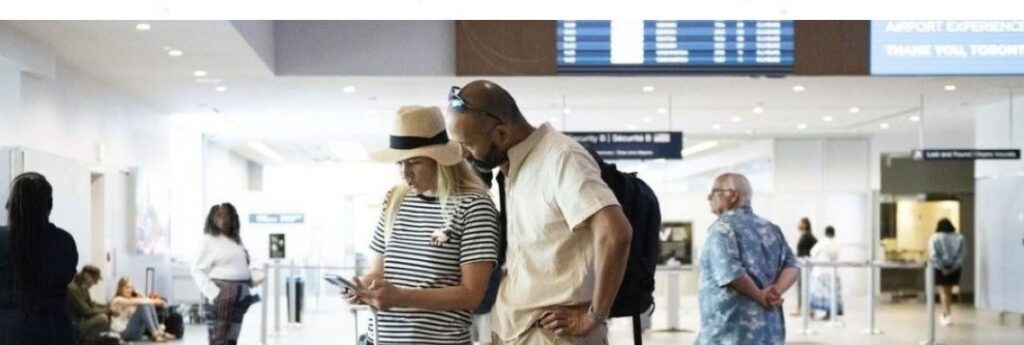Travel and transport industries continued to get systems back online on the weekend after a widespread technology outage on Friday that threatened to cause travel delays for days, according to experts. Airlines were hardest hit by the global security outage, with thousands of flights cancelled on Friday, and many more passengers delayed or stranded into the weekend.
The trouble was sparked by an update issued by cybersecurity firm CrowdStrike and only affected its customers running Microsoft Windows, the world’s most popular operating system for personal computers. It was not the result of hacking or a cyberattack, according to CrowdStrike, which apologized and said a fix was on the way.
By Friday night, about 4,400 flights were cancelled globally, according to FlightAware, and tens of thousands were delayed by the flight cancellations, leading to long lines at airports in North America, Europe, Asia, and Latin America as airlines lost access to check-in and booking services in the heart of the summer travel season and airports faced problems with security delays.
Canada
At Pearson airport in Toronto, as well as the main airports in Vancouver, Calgary and Montreal, the vast majority of arrivals and departures between Canada and the US were postponed or called off. Passengers saw early morning departures to cities including Houston, Denver and Washington, DC, delayed for up to five hours. Flights from Chicago and Newark, NJ, were cancelled.
Air Canada said it experienced no major impact to its operations, however US airlines were among the carriers affected, including United and Delta Air Lines, which have partnerships with Air Canada and WestJet, respectively. Pearson also reported on Friday that WestJet, Flair, and Sunwing flights had not been affected.
Porter Airlines, however, initially grounded flights until noon and extended cancellations until 3 p.m. EDT due to the outage. By 12:30 p.m., the country’s third-largest airline had scrapped 56 flights, or 26% of its 212 scheduled takeoffs, according to aviation data firm Cirium. More than 7,000 customers were affected, and its website was down until mid-afternoon, with some disruptions continuing into the evening.
However, aviation consultant Duncan Dee observed, “From a global perspective, the impact in Canada is pretty minimal compared to what happened in other parts of the world,” pointing to widespread disarray and what some observers described as chaos at airports in parts of Europe and Asia.
Some travellers will likely have to wait up to 72 hours before they reach their destinations, Dee said, “not to mention the rolling delays that will occur as a result of this.”
On its website on the weekend, Pearson airport was still advising: “A global IT outage is causing tech disruptions to some airlines. Flight delays and cancellations may occur. For specific flight information, please contact your airline directly.”
Border
The disruption wasn’t limited to air travel. At the US-Canada border, Windsor Police reported long delays at the crossings at the Ambassador Bridge and the Detroit-Windsor tunnel. Even cars with people approved for a US Customers and Border Protection “Trusted Traveller” program for low-risk passengers waited up to 90 minutes.
What’s next?
By late afternoon Friday Eastern time, the worst was over, though there were still lingering cancellations and delays due to the cascading effect of the disruption.
The British National Cyber Security Center’s former head Ciaran Martin observed that “because the nature of the crisis is that it went very wrong very quickly. It was spotted quite quickly and essentially it was turned off.”
But he added that while some businesses would be able to get back to normal very quickly, for sectors such as aviation it would take longer. “If you’re in aviation, you’ve got people, planes and staffs all stranded in the wrong place… So, we are looking at days. I’d be surprised if we’re looking at weeks.”
Jesse Neugarten, founder and CEO of travel-search site Dollar Flight Club noted that because many flights are sold out or have just a few empty seats during the peak summer vacation season, airlines have less room to accommodate passengers from cancelled flights.
Global havoc
The breadth of the outages highlighted the fragility of a digitized world dependent on just a few providers for key computing services.
The head of a nonprofit group that promotes building the internet says outages like this one will happen in the future because of “our world of complex, interconnected systems.”
“The important part is how we learn from them and how we improve the resilience of our systems, so that similar issues do not happen again,” Andrew Sullivan, CEO of the nonprofit Internet Society said
Besides grounding flights and affecting borders, the faulty update caused widespread technological havoc globally, including affecting banks, hospitals, government offices, and small businesses.
Not even Starbucks was spared from the fallout. The coffee chain said its mobile order-ahead and pay features were temporarily out of order.
“I don’t know what’s worse,” traveller Robert Harris said in a social media post from Pearson Airport in Toronto, “the ground stoppage or the fact that the Starbucks order ahead isn’t working. Both are causing massive lines.”

